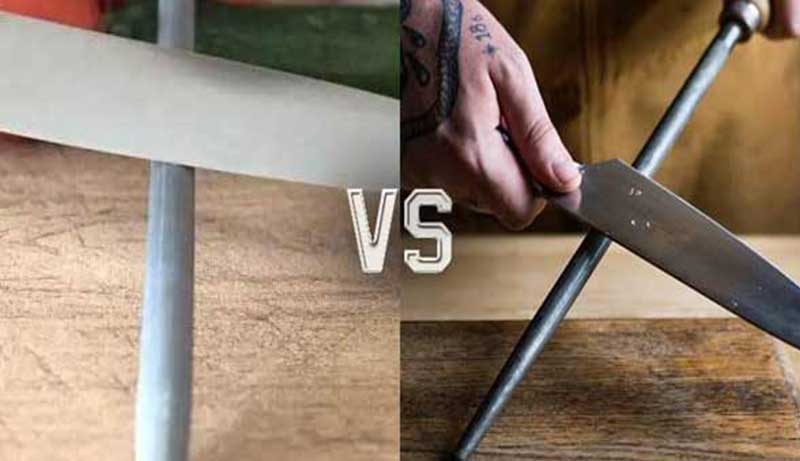Honing Rod and Sharpening Rod, are quite similar visually and are frequently mistaken with one another.
There is a lot of misunderstanding about the distinction between honing steels and sharpeners. Honing steels are frequently mislabeled as sharpening rods, even when they are sold, particularly online.
However, there is a significant difference between Honing Rod vs Sharpening Rod instruments.
What is Honing Rod

In a simple word, this is a rounded stick-like rod that is typically composed of steel, ceramic, or diamond-coated steel. They’re typically used to straighten the edge of a knife.
Honing is simply maintaining an already sharp edge. A honing steel is used to bring the blade’s edge back into alignment. When you are using a knife for a long time, the edge of the knife gets bent.
When you use a knife, it will inevitably come into contact with a hard surface, whether it’s a cutting board or a piece of chicken bone; it’s an inescapable byproduct of cooking. When the knife edge makes contact with these hard surfaces, it bends and folds.
It is recommended that you hone your knife on a regular basis; some people prefer to hone their blades after each use. You’ll want to hone your blade after sharpening it to keep the finely sharpened edge you just worked so hard to get. You’ll need honing steel or sharpening steel for this.
To begin using a honing steel, hold it vertically with the tip on the counter. Apply little pressure as you slide the blade down the rod at a 15-degree angle. Rep about a half-dozen times, alternating sides. Besides, you can choose some Tracker Knife.
Functions of Honing Rod

Honing steel, on the other hand, is used to restore the bent edge rather than sharpen it. This is referred to as burr folding. You can essentially do this every time before using your knife. This ensures that the edge is straight and not bent.
The primary distinction between sharpening steel and honing steel is hence whether or not the material is removed. Honing steels are composed of steel that does not sharpen. Sharpening steels are harder than steel because they are ceramic or have a diamond finish.
Diamond-coated sharpening steels are quick to sharpen, but they also remove a lot of steel. As a result, if you use your knives on a regular basis, it is recommended to use ceramic sharpening steel.
You’ll want to hone your blade after sharpening it to keep the finely sharpened edge you just worked so hard to get (and after each use). You’ll need honing steel or sharpening steel for this ($60; Zwilling). Despite its name, it will not sharpen your knife; instead, a “sharpening” steel is designed for honing.
To begin using honing (or sharpening) steel, hold it vertically with the tip on the counter. Apply little pressure as you slide the blade down the rod at a 15-degree angle. Rep about a half-dozen times, alternating sides. Additionally, you can check our review on Large Chopper Knife.
What is Sharpening Rod

You’ll want to hone your blade after sharpening it to keep the finely polished edge you just worked so hard to get (and after each use). You’ll need honing steel or sharpening steel for this. Despite its name, it will not sharpen your knife; instead, a “sharpening” steel is designed for honing.
To begin using a honing steel, hold it vertically with the tip on the counter. Apply little pressure as you slide the blade down the rod at a 15-degree angle. Rep approximately a half-dozen times, switching sides.
Functions of Sharpening Rod

Sharpening a knife is a separate procedure. When we sharpen a knife, it is because the knife edge has become so out of alignment, or is so damaged, that it cannot be realigned using a honing steel. That edge can no longer be saved, and we must create a new one.
Sharpening, on the other hand, is the process of removing material off the edge of a blade, generally by grinding it against a sharpening stone. If you sharpen your knife on a regular basis, you shouldn’t need to sharpen it more than twice a year, depending on how frequently you use it.
So, what is the distinction between honing and sharpening? Sharpening removes material from the blade to create a fresh, sharp edge, whereas honing maintains the blade’s sharpness by pushing the knife’s edge back to the center.
While electric sharpeners are convenient, others claim that they might be overly harsh and wear out your blades. They do, however, take a lot of the labor out of the procedure. Sharpening stones allow you to get a razor-sharp blade without losing too much steel.
To use a sharpening stone, hold the edge of the blade at a 20-degree angle against the stone. Apply pressure on the with your other hand as you move the blade from the heel to the tip of the stone.
Here comes the sharpener. Sharpeners must be formed of a harder substance than the knife, or from an abrasive surface, such as stone; sharpening stones are commonly referred to as whetstones or water stones.
The substance must be tougher since it must remove a small layer of steel blade to reveal a brand new and sharp edge beneath. We’re talking about really fine particles, almost like steel dust.
Final Words

Honing Rod and Sharpening Rod are two different things. Sometimes people get confused between two things. So they get in trouble. But now we have described the differences between the Honing Rod and Sharpening Rod. hopefully the next time you won’t be in trouble selecting the right processes to sharpen the knife.
